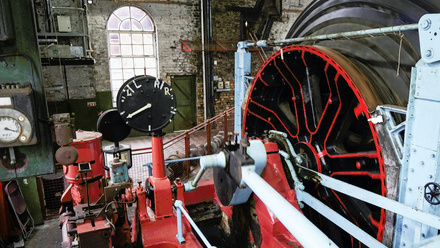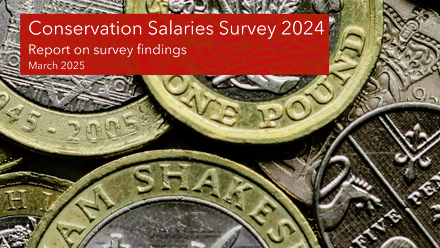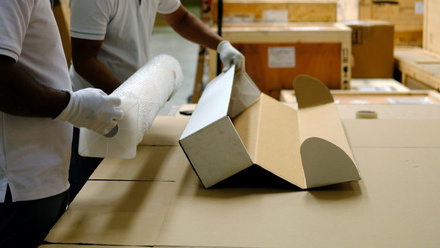Introduction
Icon’s vision is for cultural heritage to be valued and accessible, and for its future to be enhanced and safeguarded by excellence in conservation.
For the last five years we have been working hard to achieve this vision through our Strategy 2017-2022, which focuses on three areas: advocacy, excellence, and engagement. We believe that we have been very successful in many areas of activity and the positive outcomes are captured in our impact stories and our annual Impact Report.
However, as our current strategic plan comes to an end soon, we have recently started to develop Icon’s next strategy. The first step was to make sure that we fully understood the context in which we are operating and how that might change over the next five to ten years. So, over the last six months Icon has co-ordinated a series of strategic workshops with a range of stakeholders, including members, group and network representatives, funders, and senior staff in a variety of heritage organisations. We have also talked individually to others. We are extremely grateful to everyone who has given their time to share thoughtful insights and creative ideas. After the upheaval of the last 18 months it is more important than ever that we work to ensure that our mission can be achieved against a backdrop of significant change and uncertainty across the heritage sector, and more widely in the global economy and society.
Commentary
As part of the strategic workshops we carried out “horizon scanning” exercises where we tried to capture the key external opportunities and threats that are likely to arise over the coming decade. To help focus our thinking we used the PESTLE structure to group the opportunities and threats under the following headings:
- Political e.g. devolution, Government priorities, political issues
- Economic e.g. funding priorities, competition, markets, impact of Coronavirus
- Socio-cultural e.g. social trends, public attitudes, workforce diversity
- Technological e.g. skills, IT, digital divide
- Legal e.g. legislation, regulations, policies
- Environmental e.g. climate crisis
Having identified the opportunities and threats we then went on to consider what impact they might have on the conservation profession. Working collaboratively in small groups we were able to collate the suggestions in a series of Google sheets. These have now been combined into this summary report.
The findings from this research are unlikely to be a surprise to members or to stakeholders. Some of the most frequently cited threats were the obvious (and longstanding) issues such as lack of Government support for culture, cuts to funding, climate change, and barriers to entry into the conservation profession. However, the topic that came up most frequently in conversation was recognition, or rather the lack of recognition of the value of conservation and they ways in which conservators’ work benefits society.
Over the last few years Icon has worked hard to raise the profile of conservation, but this is not a task that will ever be completed. It seems clear that Icon and its members must continue to do all we can to champion not just the intrinsic value of what we do but also its relevance to people, communities, and societies. We’ve become skilled at articulating why conservation matters in the abstract, but now we need to focus on demonstrating more clearly why conservation should matter to the public, stakeholders, clients, employers, decision-makers etc. and how conservation can contribute to solving wider societal problems.
This vital work will be a key strand of our next strategic plan.
Political
| What are the key external opportunities and threats in the coming decade? | Thematic area | Threat or opportunity? | What might be the impact on the conservation profession? |
| Ongoing political battles ("Culture Wars") about what we choose to preserve and how this should be done e.g. recent high profile campaigns relating to de-colonisation, statues, National Trust report on slave trade connections. | Policy | Threat | Erosion of independence of museums and institutions - more Government pressure to conform with policy. Less political / public support for museums depending on viewpoint. "Culture Wars" are divisive and have a negative impact on engagement. |
| Further devolution / break-up of the UK. | Policy | Threat | New relationship with Icon Scotland Group and organisations in Scotland would need to be developed. |
| Support for vocational training from Government. | Training | Opportunity | Capitalizing on interest in apprenticeships and other work-based learning programmes to provide different ways into the profession could help to tackle barriers to entry and increase diversity. |
| Impact of Brexit. | Workforce | Threat | Potential for labour and material shortages; rising costs. Narrower pool of people in terms of training and employing conservators. (Many conservators currently working in the UK are from other European countries.) |
Economic
| What are the key external opportunities and threats in the coming decade? | Thematic area | Threat or opportunity? | What might be the impact on the conservation profession? |
|---|---|---|---|
| Uncertainty regarding post-Covid funding priorities for cultural heritage and conservation, but conservation is unlikely to be a priority within national and regional museums, galleries and institutions. | Funding | Threat | Exhibition plans may be changed and scaled down. There will be less money available for conservation projects and staff leading to the potential for the sector to shrink. Potential negative impact on freelancers as many rely on funding trickling down through the ecosystem from the major institutions. Small practices without a pipeline of work may no longer be commercially viable and may fail. |
| Grant making bodies are changing their priorities and there may be less interest in funding conservation. | Funding | Threat | Exhibition plans may be changed and scaled down. There will be less money available for conservation projects and staff leading to the potential for the sector to shrink. Potential negative impact on freelancers as many rely on funding trickling down through the ecosystem from the major institutions. Small practices without a pipeline of work may no longer be commercially viable and may fail. |
| Decrease in local authority support for museum services. | Funding | Threat | Local authorities see culture as being about festivals - not about museums and heritage. Conservation is not a priority in local authorities and not well funded. Conservation and museums service are but back or scrapped. |
| Tendering processes remain very challenging for small businesses. | Funding | Threat | Small businesses waste time on unsuccessful tenders. Running a conservation business becomes less financially viable. |
| Lack of training placements and internships that support early career professionals to gain the skills needed for the workplace. | Training | Threat | Emerging professionals are unable to gain the necessary skills and experience. Museums and studios are not able to find staff with the skills that they need. |
| Socio-economic issues mean that attracting a diverse workforce is a major challenge. | Workforce | Threat | The high cost of training and low wages post-training are a barrier to entry to the conservation profession. The difficulty of tackling these issues makes it difficult for the sector to become more diverse. |
| Unemployment (particularly high levels of youth unemployment). | Workforce | Opportunity | Social problems but also an opportunity to create more places for vocational trainees and to grow a more representative workforce. |
Socio-cultural
| What are the key external opportunities and threats in the coming decade? | Thematic area | Threat or opportunity? | What might be the impact on the conservation profession? |
| Current interest in re-use and recycling, which is driven by climate change concerns. | Climate | Opportunity | Potential to gain support for conservation and build a greater appreciation of the skills need to care for objects. |
| Conservation should strive to be better integrated with other care of collections professions. | Collaboration | Opportunity | Conservation gains greater recognition and support. Collaboration and shared working/learning is increased. Conservators are included in important observations about the future of collections/museums etc. |
| Potential to increase connections and collaborations with other organisations in the cultural heritage ecosystem. | Collaboration | Opportunity | Making better connections and partnerships could lead to greater efficiency and impact. Joining with others creates a stronger voice and supports advocacy outcomes. Sharing knowledge and resources means being able to do more with less. |
| High levels of uncertainty in all areas of life post-Covid. | COVID-19 | Threat | Forward-planning is very challenging. Lack of job security makes people willing and able to volunteer for committee / Board roles. Emerging professionals are unwilling to commit to the Pathway Membership or to begin accreditation applications. |
| Changing view of the value of cultural heritage - new materials / objects / collections. | Policy | Opportunity | Wide-reaching impact as this will require new technical understanding, and education at different levels. Need to involve a broader range of people in discussions about what heritage is or should be. |
| Changing view of heritage - contested heritage / culture wars / decolonisation | Policy | Opportunity | Wide-reaching impact as will require new ethical understanding and education at different levels. Needs to involve a broad range of people in discussions about new approaches. |
| Organisational and cultural change in museums, galleries and institutions. | Policy | Threat | Greater emphasis on commercial activity, interpretation and education could lead to less resources being devoted to conservation and heritage science. |
| Not enough people - the public, stakeholders, decision-makers, clients - understand what conservation is and why is matters. | Recognition | Threat | Conservators' work is not valued because the contribution it makes to individuals and society is not recognised. This feeds the spiral of lack of funding and investment. |
| Current public interest in conservation arising from TV shows such as The Repair Shop and Secrets of the Museum (V&A). | Recognition | Opportunity | Capitalizing on the positive opportunity for advocacy and outreach could increase the visibility of and respect for conservation. But this needs to counter the problem that TV programmes paint a false picture of what conservation is and the time/money required to treat objects. The focus is also often on restoration rather than conservation. |
| Conservators are not valued by the museums, galleries and institutions in which they work. | Recognition | Threat | If there are no conservators in senior leadership roles (director level) then there is limited ability to influence and to create positive change. This feeds the spiral of lack of funding and investment. |
| Conservation and conservators are not valued by the public / clients. | Recognition | Threat | Very little grassroots advocacy for conservation. Fewer clients commissioning work from conservators. |
| Teaching in schools is moving increasingly away from arts subjects; there is little support for history and practical subjects. | Training | Threat | Fewer young people are aware of potential careers in conservation. Fewer young people leave school with practical skills. Fewer young people gain an appreciation of culture and heritage. Universities and vocational courses have to adapt in order to attract students and teach basic skills. |
| Conservation is not visible in schools. | Training | Threat | Young people are not aware of conservation as a possible career and therefore there is limited opportunity for the profession to attract a more diverse range of practitioners. |
| Fragmenting of conservation into many specialists disciplines. | Workforce | Threat | Less cross-disciplinary working. Icon becoming less inclusive of all conservation professionals. |
| Heritage science infrastructure is under threat. | Workforce | Threat | Less availability of trained heritage scientists to support conservation and research. |
| Conservators and the conservation profession are generally resilient. | Workforce | Opportunity | Conservators have the skills and attributes to be able to adapt to changing circumstances. This means that they may be able to spot new opportunities and move into new areas of practice. |
| Numbers of students coming out of training/universities is not matched against demand/ jobs available. | Workforce | Threat | The oversupply of applicants for a limited number of roles means that talented and passionate conservators leave the profession because they cannot find work, or they migrate to other countries. |
| Sector wide loss of skills in craft, culture and heritage professions has secured media interest. The HCA Red List of Endangered Crafts and the APPG for Craft have brought the loss of skills to the attention of politicians. | Workforce | Opportunity | Capitalizing on the positive opportunity for advocacy and outreach could increase the visibility of and respect for conservation. Looking outwards and working with allied crafts and disciplines could raise the profile of conservation could attract new supporters. Being more inclusive in terms of our definition of who is a conservator means that we could welcome more people working with built heritage into Icon. |
| Interventive treatment skills / practical bench skills are less valued than preventative skills. | Workforce | Threat | Fewer conservators are able to treat objects to acceptable standards. |
Technological
| What are the key external opportunities and threats in the coming decade? | Thematic area | Threat or opportunity? | What might be the impact on the conservation profession? |
| Increased digital access and public interest in engaging online. | Digital | Opportunity | Increased engagement with heritage through virtual channels might lead to a greater enthusiasm to engage with the real objects in their settings. Digital platforms provide an opportunity for conservators to showcase their work e.g. through video and timelapse photography. Potential to increase the reach of conservation stories and Icon activities. |
| Success of online webinars and other virtual training and CPD events. | Digital | Opportunity | Ability to share learning, research and good practice with a wider (and global) audience. Increases participation and engagement. Creates an international community and allows members to expand their professional networks. |
Legal
| What are the key external opportunities and threats in the coming decade? | Thematic area | Threat or opportunity? | What might be the impact on the conservation profession? |
| Changes to culture and heritage legislation and policy (both secular and ecclesiastical). | Policy | Threat | Lessening in protection for heritage structures. Less emphasis on best practice in conservation. |
| Ongoing change and development in international conservation charters. | Policy | Opportunity | Potential to make a positive impact if we are able to contribute, but could be harmful if the changes don't include a UK perspective. Political withdrawal from Europe makes UK conservators less visible. |
Environmental
| What are the key external opportunities and threats in the coming decade? | Thematic area | Threat or opportunity? | What might be the impact on the conservation profession? |
| Risks to collections (and people / society) arising from climate change | Climate | Threat | Need to adapt practice to be more energy efficient and carbon conscious e.g. passive environmental control. Need to find alternatives to harmful materials used in the studios, though new "green" materials may a higher financial cost. Increased problems with pest management. Challenging conversations will be needed about what we can realistically expect to save for future generations. |
Horizon Scanning - PESTLE Analysis
The PESTLE tables are avaliable to download as a single PDF document.






